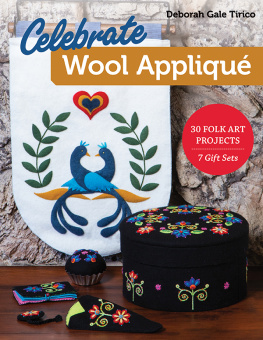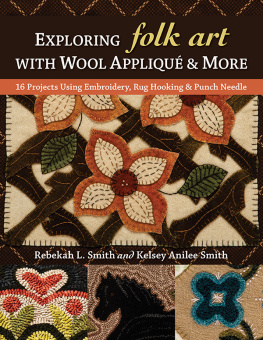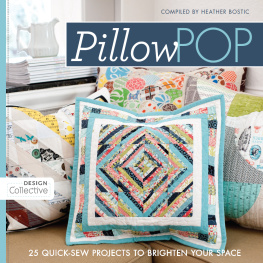Publisher: Amy Marson
Creative Director: Gailen Runge
Art Director: Kristy Zacharias
Editor: S. Michele Fry
Technical Editors: Julie Waldman and Gailen Runge
Cover/Book Designer: April Mostek
Production Coordinators: Jenny Davis and Freesia Pearson Blizard
Production Editor: Alice Mace Nakanishi
Illustrator: Deborah Gale Tirico
Photo Assistant: Mary Peyton Peppo
Subject photography by Diane Petersen, style photography by Nissa Brehmer, and instructional photography by Deborah Gale Tirico and Frank Luca Tirico, unless otherwise noted
Published by C&T Publishing, Inc., P.O. Box 1456, Lafayette, CA 94549
Dedication
For my Frank
My husband, friend, and partner in life
Acknowledgments
So many people in my life have been supportive during my needlework journey, but none more than my mother, Doris, who put a needle in my hand when I was only a small girl and became my most devoted fan.
Big hugs for my husband, Frank, who hand dyed wool, made countless trips to the post office and airport, and never complained when the dining room looked more like a quilt studio.
My dear friend Helene cheerfully traveled with me to classes, shop hops, quilt shows, and embroidery seminars, sharing the fabrics and threads and always making it more fun.
I am grateful to my amazingly supportive sisters, Cindy, Carol, Janet, and Robin, who have oohed and aahed at every showing of my work since I was a teenager.
I must also recognize my lifelong friend and colleague Mari. Maris encouragement and support was unwavering as she held the fort at Gemini Studio. Many thanks!
I also wish to thank all my pilot students for reading directions, making excellent suggestions, and helping me become a better instructor.
Foreword
My sister, Deb, has always been a stitcher. Her talent with a needle showed itself early and came seemingly out of nowhere. I dont know where she learned how to do this, our astonished mother would say about one of her creations. Shes just a little girl and everything she does is beautiful!
Deb was a teenager when the hippie culture brought gauzy peasant blouses, fringed miniskirts, and embroidered jeans into our home. Styles were changing, and Deb, always the savvy older sister, knew exactly how to make a fashion statement. I remember her helping me jazz up my jeans by showing me how to embroider the bottom of my bell-bottoms. First she drew the design using a pen. Next, she patiently showed me how to embroider the flowers, curlicues, and iconic peace symbols that were the mainstays back then. How I loved the chain stitch that meandered all along the hemline, the glossy satin stitch of the daisies, and the French knots that dotted the design like exclamation points. At school, my jeans were a hit!
Embroidery became Debs therapy. The week before her wedding, when the house was in a flurry of preparations and plans, Deb was squirreled away in the den embroidering sachet pillows as gifts for her bridal attendants. Her work was always beautiful, but now it was also an expression from the heart. I played the piano, so my sachet displayed an intricately embroidered keyboard; the sewer in the family had a sewing machine on hers; and the sister who accompanied us at campfire sing-alongs had a guitar on hers.
Years later, at a family retreat at Lake George, New York, Deb organized a quilting class. The fact that we were all novices didnt deter her. She deftly distributed all the materials we needed to make a simple quilted potholder and then proceeded to show us how to go about making it. I remember marveling at her instructional style. She was so confident and so patienta born teacher. When we faltered, she simply redirected us. She knew the end result would be prettytoo pretty, in fact, to use. I hung it on the wall.
Now, Deb has embarked on another creative journey with this collection of unique designs to stitch. Each design began as an idea. The result is where Debs curiosity, creativity, and passion ultimately led her. I hope you enjoy stitching these designs as much as she enjoyed creating them. Happy stitching!
Janet Aaronson
Somerville, New Jersey
Introduction
As an avid fan of appliqu I have always been intrigued with wool penny rugs and their construction and history. I was creating my own designs using raw-edged fabric and the blanket stitch when I was just 10 years old, and to this day it remains one of my favorite stitching methods.
Unlike many designs in felted wool today, my work is not primitive in design. Coming from a formal appliqu background, I use matching wool threads and dimensional appliqu methods, and I embellish my work with embroidery. As a result, my designs are sophisticated and dimensional and offer clarity to their subject, making them quite distinctive.
The organic and forgiving nature of felted wool allows me to sculpt my table rugs and home fashion accessories, bringing a lush, colorful accent to any room. My needle-slanting technique and methods for marking embroidery guides will appeal to the embroiderer, the quilter, and any lover of hand sewing.
The projects in this book are functional, are quick to stitch, and make wonderful gifts. The patterns include both small and large projects that can be completed on vacation, while traveling, in between larger projects, or as quick gifts for friends.
My inspiration for these designs comes from a variety of subjects, and I have included them so that you, too, may begin to think about what appeals to you designwise in the world and then translate those things into sculpted wool creations of your own.
Happy stitching!
Deborah Gale Tirico

The Basics
ABOUT FELTED WOOL
I am often asked about felted wool, and this is how I explain the differences in wool fabric.
Felted wool is actually woven wool yardage that has a weft and a warp. When this yardage is felted, it is shrunk in hot water followed by high-heat drying, causing it to constrict and become dense. This fabric is easy to needle because the holes between the warp and weft remain. Once felted, woven wool yardage will not easily fray.
Wool felt is made from wool roving, which is pressed into sheets using hot water and high heat, causing it to become dense. This fabric is a bit more difficult to needle because unlike a woven fabric it has no holes.
Some wool felt is actually a blend of 70% wool and 30% polyester and behaves well in a variety of applications because it has absolutely no fray.
Craft felt is made from 100% synthetic materials. Some is even made using recycled plastic bottles a much different feel and form.
I use felted wool for all my base fabrics and the majority of my appliqu fabrics. My process is to felt all my own base fabrics (white, off-white, and black), dye and overdye some of my own colors when I am unable to procure suitable colors, and buy from felted wool houses all the colors that are used in smaller pieces.
I hope your journey using this book will encourage you to felt your own wool, experiment with a bit of dyeing and overdyeing, and see how beautifully these natural fibers needle and behave as you sculpt your own creations.
FELTING WOOL
Wool yardage can be felted by washing it with hot water and a little detergent and then drying it at high heat. The fabric will shrink nicely and eliminate the large amount of fraying that would result from using wool yardage that is not felted.
Fabrics from wool clothing can also be felted, but use some caution when selecting them. The following guidelines will help in choosing fabrics to recycle and use for felted wool creations.
Next page













